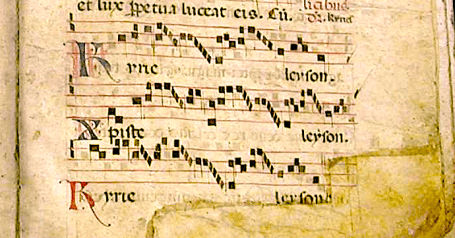 AGNIFICENT! There is no other word for it. I am speaking of the Palestrina’s Kyrie based on the Gregorian Kyrie II (“Fons Bonitatis”), which is divided—as you might guess—into three marvelous sections. You can listen all three sections by visiting Lalemant Polyphonic and scrolling to 81668. I strongly encourage you to do this! And just where does “Kyrie Fons Bonitatis” come from? We remember that prior to the Council of Trent, the prayers at Mass were “troped.” Many erroneously believe the Kyrie was the only thing troped, but that’s not even close to true. The Gloria, Sanctus, Agnus Dei—and even the readings!—were troped.
AGNIFICENT! There is no other word for it. I am speaking of the Palestrina’s Kyrie based on the Gregorian Kyrie II (“Fons Bonitatis”), which is divided—as you might guess—into three marvelous sections. You can listen all three sections by visiting Lalemant Polyphonic and scrolling to 81668. I strongly encourage you to do this! And just where does “Kyrie Fons Bonitatis” come from? We remember that prior to the Council of Trent, the prayers at Mass were “troped.” Many erroneously believe the Kyrie was the only thing troped, but that’s not even close to true. The Gloria, Sanctus, Agnus Dei—and even the readings!—were troped.
Here’s a rehearsal video we made for Part 1 of 3. (I again humbly request that you go listen to the other sections, as well.)
Kyrie II (“Fons Bonitatis”) has remained remarkably stable. Look how it appeared in Cantus Varii, a marvelous collection by Solesmes printed in 1928:
A 2011 publication from Germany seemingly copied this 1928 edition without any changes, although it inserted “tropeless” Editio Vaticana repetitions which puzzle me:
A 2016 publication with variations from the Sarum Use also seemingly copied the 1928 version verbatim, with a few very minor changes (e.g. Pneumáte instead of Pnéumatis):
In the most wonderful way, Palestrina derives his polyphonic lines from the complicated chant melodies of Kyrie II. For example:

 HENEVER POSSIBLE, we must locate the version (“variant”) of the plainsong which Palestrina was looking at when he wrote his Mass. But which version was it? This question is sometimes impossible to answer because we know so little about the lives of the Renaissance composers. However, as I mentioned earlier, Kyrie II is relatively “stable” compared to other chants, so we can be fairly certain the version Palestrina had before him is similar to what we have in the Editio Vaticana.
HENEVER POSSIBLE, we must locate the version (“variant”) of the plainsong which Palestrina was looking at when he wrote his Mass. But which version was it? This question is sometimes impossible to answer because we know so little about the lives of the Renaissance composers. However, as I mentioned earlier, Kyrie II is relatively “stable” compared to other chants, so we can be fairly certain the version Palestrina had before him is similar to what we have in the Editio Vaticana.
Consider this version from the 14th century:
Here’s one from the late 15th century:
Another version from the 15th century:
A version from 1525AD:
Here is a version from 1580AD:
A version from 1591AD:
Here is a version from the 16th century:
Another from the 16th century:
Here’s the version Dr. Peter Wagner chose in his 1903 Kyriale:
And here’s the version Mocquereau chose for his 1903 Liber Usualis. Notice the spots where it differs from Pothier’s Editio Vaticana:
Here is the 1863 edition by Father Hermesdorff, the teacher of Peter Wagner (considered a “corrupt” edition of plainsong):
Here is another “corrupt” version of Kyrie II printed in 1857:
The particular way Palestrina places the chant melodies from Kyrie II into his version is stunning. I was going to say Part 3 was my favorite, but Part 2 is also magnificent—and so is Part 1. So it’s all my favorite! The rehearsal videos we made simply don’t do justice to this masterpiece.
In grad school I remember thinking Palestrina wasn’t as interesting as certain other composers; but I was dead wrong.
![]()
By the way, here is a (pretty terrible) organ accompaniment for “Kyrie Fons Bonitatis” by Dr. Auguste Le Guennant (d. 1972)
![]()














